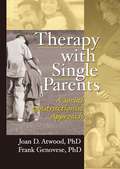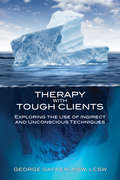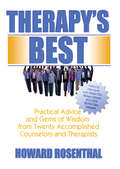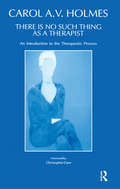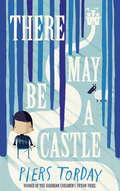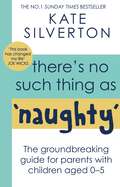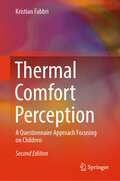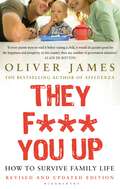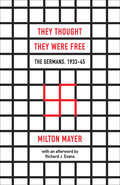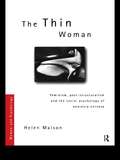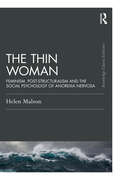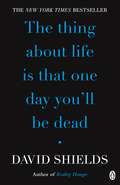- Table View
- List View
Therapy with Men after Sixty: A Challenging Life Phase
by Barry McCarthy Emily McCarthyTherapy with Men after Sixty is a breakthrough book for professionals that helps them open their clients’ minds to new ways of thinking, behaving, and feeling about the aging process. The authors adopt a realistic but optimistic tone as they carefully examine the psychological, relational, and sexual aspects of life after 60, while also dispelling common myths. Topics addressed include how to build and maintain Psychological Well Being, have quality relationships, build self-esteem, and deal with crisis and loss. Practical topics, such as financial issues, living situations, and relationships with adult children and grandchildren are addressed through guidelines, skill exercises, and case studies. Each chapter helps mental health professionals to account for individual, couple, cultural, and value differences, making this an unparalleled resource for helping men successfully meet the challenges of aging.
Therapy with Single Parents: A Social Constructionist Approach
by Joan D Atwood Frank GenoveseProvide effective counseling to members of single-parent familiesWith more than half of all first marriages ending in divorce, it&’s time to re-think the notion that "divorce" means "failure." Therapy with Single Parents focuses on the strengths of the single-parent family rather than its weaknesses, stressing the need to look at the socially constructed norms, values, and definitions associated with marriage and family in order to provide effective counseling. This unique book examines experiences that are common to single parents and presents interventive strategies for treating single-parent family issues, drawing on clinical case studies to provide technical knowledge in everyday language.Current research shows that single parents account for 27 percent of family households that include children under 18 and that the number of single mothers in the United States more than tripled between 1970 and 2000. Therapy with Single Parents challenges outdated notions that the single-parent family is somehow deficient and associated with adjustment problems in children. It doesn&’t ignore the anger, pain, sadness, and guilt experienced by many members of single parent families but offers therapeutic considerations from a more balanced approach. The book examines the social, psychological, and sexual experiences of newly single parents and addresses the ups and downs they&’ll face in dealing with schools, the workplace, and social services. Therapy with Single Parents examines: social and psychological differences between divorce and widowhood cognitive-behavioral principles of single-parent families what children can learn from divorce dealing with the ghosts of past relationships relationship rules dealing with adult children and extended families the effect of change in divorcing families the feminization of poverty the therapeutic value of social networksTherapy with Single Parents is an invaluable resource for psychologists, professional counselors, social workers, and marriage and family therapists. The book presents a thorough, in-depth examination of the single-parent family system as a viable, healthy family form.
Therapy with Single Parents: A Social Constructionist Approach
by Joan D Atwood Frank GenoveseProvide effective counseling to members of single-parent familiesWith more than half of all first marriages ending in divorce, it&’s time to re-think the notion that "divorce" means "failure." Therapy with Single Parents focuses on the strengths of the single-parent family rather than its weaknesses, stressing the need to look at the socially constructed norms, values, and definitions associated with marriage and family in order to provide effective counseling. This unique book examines experiences that are common to single parents and presents interventive strategies for treating single-parent family issues, drawing on clinical case studies to provide technical knowledge in everyday language.Current research shows that single parents account for 27 percent of family households that include children under 18 and that the number of single mothers in the United States more than tripled between 1970 and 2000. Therapy with Single Parents challenges outdated notions that the single-parent family is somehow deficient and associated with adjustment problems in children. It doesn&’t ignore the anger, pain, sadness, and guilt experienced by many members of single parent families but offers therapeutic considerations from a more balanced approach. The book examines the social, psychological, and sexual experiences of newly single parents and addresses the ups and downs they&’ll face in dealing with schools, the workplace, and social services. Therapy with Single Parents examines: social and psychological differences between divorce and widowhood cognitive-behavioral principles of single-parent families what children can learn from divorce dealing with the ghosts of past relationships relationship rules dealing with adult children and extended families the effect of change in divorcing families the feminization of poverty the therapeutic value of social networksTherapy with Single Parents is an invaluable resource for psychologists, professional counselors, social workers, and marriage and family therapists. The book presents a thorough, in-depth examination of the single-parent family system as a viable, healthy family form.
Therapy with Stepfamilies
by Emily B. Visher John S. VisherFirst published in 1996. Routledge is an imprint of Taylor & Francis, an informa company.
Therapy with Stepfamilies
by Emily B. Visher John S. VisherFirst published in 1996. Routledge is an imprint of Taylor & Francis, an informa company.
Therapy with Tough Clients: Exploring the Use of Indirect and Unconscious Techniques
by George GafnerWhether you're fairly new to therapy or you've practiced for many years, no doubt at times you've found yourself stumped with certain clients who leave you feeling perplexed and discouraged with that 'I-just-don't-know-what-to-do-next' feeling. George Gafner has been there and that's precisely why he wrote this book. The reality is that today's cookie-cutter treatment mentality presupposes that all people with, say, depression, can be treated essentially the same way, which virtually ignores the established fact that a good deal of a person's mental functioning is governed not by conscious choice but instead by automatic, or unconscious, forces that lie outside voluntary control
Therapy With Young Men: 16-24 Year Olds in Treatment (The Routledge Series on Counseling and Psychotherapy with Boys and Men)
by Dave VerhaagenYoung adult men in their late teens and early twenties are statistically the least happy of any group of males surveyed. What’s more, scholarly research tells us that adolescent boys and young men have the highest rates of behavioral problems, completed suicides, and drug and alcohol problems of any demographic group. They also tend to have greater problems managing their emotions and successfully negotiating close interpersonal relationships, which makes therapy more complex and challenging. However, when done well, therapy with young men can be highly effective and quite rewarding for both the therapist and client. In Therapy With Young Men, Verhaagen presents a comprehensive model of therapy with young men that addresses each of these concerns, beginning with the rapport and engagement process, and then moving to ways to increase motivation for changing problem behaviors and increasing adaptive skills. The book describes a wide range of novel, effective cognitive-behavioral interventions that can readily be employed in the therapeutic process.
Therapy With Young Men: 16-24 Year Olds in Treatment (The Routledge Series on Counseling and Psychotherapy with Boys and Men)
by Dave VerhaagenYoung adult men in their late teens and early twenties are statistically the least happy of any group of males surveyed. What’s more, scholarly research tells us that adolescent boys and young men have the highest rates of behavioral problems, completed suicides, and drug and alcohol problems of any demographic group. They also tend to have greater problems managing their emotions and successfully negotiating close interpersonal relationships, which makes therapy more complex and challenging. However, when done well, therapy with young men can be highly effective and quite rewarding for both the therapist and client. In Therapy With Young Men, Verhaagen presents a comprehensive model of therapy with young men that addresses each of these concerns, beginning with the rapport and engagement process, and then moving to ways to increase motivation for changing problem behaviors and increasing adaptive skills. The book describes a wide range of novel, effective cognitive-behavioral interventions that can readily be employed in the therapeutic process.
Therapy's Best: Practical Advice and Gems of Wisdom from Twenty Accomplished Counselors and Therapists
by Howard RosenthalInsightful interviews with a Who&’s Who of the world&’s foremost therapistsTherapy&’s Best is a lively and entertaining collection of one-on-one interviews with some of the top therapists and counselors in the world. Educator and psychotherapist Dr. Howard G. Rosenthal talks with twenty of therapy&’s legends, including Albert Ellis, arguably the greatest clinical psychologist and therapist of our time; assertiveness training pioneer Robert Alberti; experiential psychotherapist Al Mahrer; and William Glasser, the father of reality therapy and choice theory. Each interview reveals insights into the therapists&’ personal lives, their observations on counseling, and the helping profession in general, and their thoughts on what really works when dealing with clients in need. The interviews found in Therapy&’s Best uncover treatment strategies that are often missing from traditional textbooks, journal articles, courses, and seminars related to assertiveness training, Rational Emotive Behavior Therapy (REBT), marriage and family counseling, transactional analysis, psychoanalysis, suicide prevention, voice therapy, experiential psychotherapy, and Emotion Focused Therapy (EFT). Conversations with the "best and brightest" (including two recipients of the American Psychological Association&’s Division of Psychotherapy&’s "Living Legends" award) reveal why these therapists are such effective helpers, what makes their theories so popular, and most important, what makes them tick. This unique book lets you "rub elbows" with these consummate professionals and learn more about their theories, ideas, and experiences. Therapy&’s Best includes interviews with: Dr. Albert Ellis-creator of Rational Emotive Behavior Therapy (REBT) and APA Division of Psychotherapy "Living Legend" Dr. Edwin Schneidman-the foremost expert on suicide prevention, suicidology, and thanatology Richard Nelson Bolles-author of What Color Is Your Parachute? Dr. Dorothy and Dr. Ray Bevcar-husband and wife therapists who write textbooks on marriage counseling Dr. Al Mahrer-father of experiential psychotherapy and APA Division of Psychotherapy "Living Legend" Les Greenberg-father of Emotion-Focused Therapy (EFT) Muriel James-co-author of Born to Win and many more!Therapy&’s Best is a must read for professionals who practice counseling and psychotherapy, students preparing to do likewise, and anyone else with an interest in therapy-and the people with provide it.
Therapy's Best: Practical Advice and Gems of Wisdom from Twenty Accomplished Counselors and Therapists
by Howard RosenthalInsightful interviews with a Who&’s Who of the world&’s foremost therapistsTherapy&’s Best is a lively and entertaining collection of one-on-one interviews with some of the top therapists and counselors in the world. Educator and psychotherapist Dr. Howard G. Rosenthal talks with twenty of therapy&’s legends, including Albert Ellis, arguably the greatest clinical psychologist and therapist of our time; assertiveness training pioneer Robert Alberti; experiential psychotherapist Al Mahrer; and William Glasser, the father of reality therapy and choice theory. Each interview reveals insights into the therapists&’ personal lives, their observations on counseling, and the helping profession in general, and their thoughts on what really works when dealing with clients in need. The interviews found in Therapy&’s Best uncover treatment strategies that are often missing from traditional textbooks, journal articles, courses, and seminars related to assertiveness training, Rational Emotive Behavior Therapy (REBT), marriage and family counseling, transactional analysis, psychoanalysis, suicide prevention, voice therapy, experiential psychotherapy, and Emotion Focused Therapy (EFT). Conversations with the "best and brightest" (including two recipients of the American Psychological Association&’s Division of Psychotherapy&’s "Living Legends" award) reveal why these therapists are such effective helpers, what makes their theories so popular, and most important, what makes them tick. This unique book lets you "rub elbows" with these consummate professionals and learn more about their theories, ideas, and experiences. Therapy&’s Best includes interviews with: Dr. Albert Ellis-creator of Rational Emotive Behavior Therapy (REBT) and APA Division of Psychotherapy "Living Legend" Dr. Edwin Schneidman-the foremost expert on suicide prevention, suicidology, and thanatology Richard Nelson Bolles-author of What Color Is Your Parachute? Dr. Dorothy and Dr. Ray Bevcar-husband and wife therapists who write textbooks on marriage counseling Dr. Al Mahrer-father of experiential psychotherapy and APA Division of Psychotherapy "Living Legend" Les Greenberg-father of Emotion-Focused Therapy (EFT) Muriel James-co-author of Born to Win and many more!Therapy&’s Best is a must read for professionals who practice counseling and psychotherapy, students preparing to do likewise, and anyone else with an interest in therapy-and the people with provide it.
There Is No Such Thing As A Therapist: An Introduction to the Therapeutic Process
by Carol HolmesThis book deals with the link between the purpose of therapy and the boundaries of the therapeutic situation, which - the author argues - derive from the omnipresence of the anxiety surrounding separations and death. The theoretical framework of this book is part of a developmental line from Freud, Klein and Winnicott to Langs, via Sartre and Buber.
There Is No Such Thing As A Therapist: An Introduction to the Therapeutic Process
by Carol HolmesThis book deals with the link between the purpose of therapy and the boundaries of the therapeutic situation, which - the author argues - derive from the omnipresence of the anxiety surrounding separations and death. The theoretical framework of this book is part of a developmental line from Freud, Klein and Winnicott to Langs, via Sartre and Buber.
There May Be a Castle
by Piers TordayA remarkable story about love, loss and the power of the imagination, from an award-winning, celebrated writer for children.On a frozen Christmas Eve, Mouse Mallory and his family set off across a snow-white valley to visit his grandparents.They never arrive.As the wheels skid off the icy road, Mouse is thrown from the car. When he wakes, he finds himself in a magical landscape, with only a talkative sheep and a very bossy horse for company.And they tell him: this is your story now.So begins Mouse's extraordinary quest through a world of wonder. A world of monsters, minstrels, dangerous knights and mysterious wizards; a world of terrifying danger but also more excitement than Mouse has ever known.All to find a castle, somewhere, beyond.But why is Mouse looking for a castle? As thoughts of his family back at the car begin to surface, Mouse realises this might be the most important journey he will ever make ...This is a novel about love and death. It's about the power of stories to change the way we view the world - and it's about the power of a child to change their own world. Emotionally arresting but ultimately uplifting, this is a remarkable novel for our times.
There's No Such Thing As 'Naughty': The groundbreaking guide for parents with children aged 0-5
by Kate Silverton'As a parenting support book this is in a class of its own . . . It is perhaps the most helpful book for parents of children of any age' Professor Peter Fonagy, CEO Anna Freud National Centre for Children & FamiliesWant to know the secret to tackling tantrums and tears, stopping squabbles in seconds AND lay the foundations for your child's good mental health in the process? In There's No Such Thing As 'Naughty', mum to two young children, journalist and children's mental health advocate Kate Silverton shares her groundbreaking new approach to parenting under-fives that helps to make family life so much easier and and certainly a lot more fun!Kate's unique strategies, easy-to-follow scripts and simple techniques will enable you to manage those tricky everyday challenges with ease - and help you to enjoy the strongest bond possible with your child, both now and in the years ahead. Endorsed by leading figures in the field of children's mental health, at the heart of the book is a simple and revelatory way to understand how your child's brain develops and how it influences their behaviour. Rooted in the latest science - explained really simply - this engaging, accessible and warm parenting guide will redefine how you see and raise your children, with a new understanding that for under-fives, there can be no such thing as 'naughty'.
Thermal Comfort Perception: A Questionnaire Approach Focusing On Children (Springerbriefs In Applied Sciences And Technology Ser.)
by Kristian FabbriThey F*** You Up: How To Survive Family Life
by Oliver JamesDo your relationships tend to follow the same destructive pattern? Do you feel trapped by your family's expectations of you? Does your life seem overwhelmingly governed by jealousy or competitiveness or lack of confidence? In this ground-breaking book, clinical psychologist Oliver James shows that it is the way we were cared for in the first six years of life that has a crucial effect on who we are and how we behave. Nurture, in effect, shapes our very nature. James combines the latest scientific research with fascinating interviews to show that understanding your past is the first step to controlling your present.
They Thought They Were Free: The Germans, 1933–45
by Milton Mayer“When this book was first published it received some attention from the critics but none at all from the public. Nazism was finished in the bunker in Berlin and its death warrant signed on the bench at Nuremberg.” That’s Milton Mayer, writing in a foreword to the 1966 edition of They Thought They Were Free. He’s right about the critics: the book was a finalist for the National Book Award in 1956. General readers may have been slower to take notice, but over time they did—what we’ve seen over decades is that any time people, across the political spectrum, start to feel that freedom is threatened, the book experiences a ripple of word-of-mouth interest. And that interest has never been more prominent or potent than what we’ve seen in the past year. They Thought They Were Free is an eloquent and provocative examination of the development of fascism in Germany. Mayer’s book is a study of ten Germans and their lives from 1933-45, based on interviews he conducted after the war when he lived in Germany. Mayer had a position as a research professor at the University of Frankfurt and lived in a nearby small Hessian town which he disguised with the name “Kronenberg.” “These ten men were not men of distinction,” Mayer noted, but they had been members of the Nazi Party; Mayer wanted to discover what had made them Nazis. His discussions with them of Nazism, the rise of the Reich, and mass complicity with evil became the backbone of this book, an indictment of the ordinary German that is all the more powerful for its refusal to let the rest of us pretend that our moment, our society, our country are fundamentally immune. A new foreword to this edition by eminent historian of the Reich Richard J. Evans puts the book in historical and contemporary context. We live in an age of fervid politics and hyperbolic rhetoric. They Thought They Were Free cuts through that, revealing instead the slow, quiet accretions of change, complicity, and abdication of moral authority that quietly mark the rise of evil.
They Thought They Were Free: The Germans, 1933–45
by Milton Mayer“When this book was first published it received some attention from the critics but none at all from the public. Nazism was finished in the bunker in Berlin and its death warrant signed on the bench at Nuremberg.” That’s Milton Mayer, writing in a foreword to the 1966 edition of They Thought They Were Free. He’s right about the critics: the book was a finalist for the National Book Award in 1956. General readers may have been slower to take notice, but over time they did—what we’ve seen over decades is that any time people, across the political spectrum, start to feel that freedom is threatened, the book experiences a ripple of word-of-mouth interest. And that interest has never been more prominent or potent than what we’ve seen in the past year. They Thought They Were Free is an eloquent and provocative examination of the development of fascism in Germany. Mayer’s book is a study of ten Germans and their lives from 1933-45, based on interviews he conducted after the war when he lived in Germany. Mayer had a position as a research professor at the University of Frankfurt and lived in a nearby small Hessian town which he disguised with the name “Kronenberg.” “These ten men were not men of distinction,” Mayer noted, but they had been members of the Nazi Party; Mayer wanted to discover what had made them Nazis. His discussions with them of Nazism, the rise of the Reich, and mass complicity with evil became the backbone of this book, an indictment of the ordinary German that is all the more powerful for its refusal to let the rest of us pretend that our moment, our society, our country are fundamentally immune. A new foreword to this edition by eminent historian of the Reich Richard J. Evans puts the book in historical and contemporary context. We live in an age of fervid politics and hyperbolic rhetoric. They Thought They Were Free cuts through that, revealing instead the slow, quiet accretions of change, complicity, and abdication of moral authority that quietly mark the rise of evil.
They Thought They Were Free: The Germans, 1933–45
by Milton Mayer“When this book was first published it received some attention from the critics but none at all from the public. Nazism was finished in the bunker in Berlin and its death warrant signed on the bench at Nuremberg.” That’s Milton Mayer, writing in a foreword to the 1966 edition of They Thought They Were Free. He’s right about the critics: the book was a finalist for the National Book Award in 1956. General readers may have been slower to take notice, but over time they did—what we’ve seen over decades is that any time people, across the political spectrum, start to feel that freedom is threatened, the book experiences a ripple of word-of-mouth interest. And that interest has never been more prominent or potent than what we’ve seen in the past year. They Thought They Were Free is an eloquent and provocative examination of the development of fascism in Germany. Mayer’s book is a study of ten Germans and their lives from 1933-45, based on interviews he conducted after the war when he lived in Germany. Mayer had a position as a research professor at the University of Frankfurt and lived in a nearby small Hessian town which he disguised with the name “Kronenberg.” “These ten men were not men of distinction,” Mayer noted, but they had been members of the Nazi Party; Mayer wanted to discover what had made them Nazis. His discussions with them of Nazism, the rise of the Reich, and mass complicity with evil became the backbone of this book, an indictment of the ordinary German that is all the more powerful for its refusal to let the rest of us pretend that our moment, our society, our country are fundamentally immune. A new foreword to this edition by eminent historian of the Reich Richard J. Evans puts the book in historical and contemporary context. We live in an age of fervid politics and hyperbolic rhetoric. They Thought They Were Free cuts through that, revealing instead the slow, quiet accretions of change, complicity, and abdication of moral authority that quietly mark the rise of evil.
They Thought They Were Free: The Germans, 1933–45
by Milton Mayer“When this book was first published it received some attention from the critics but none at all from the public. Nazism was finished in the bunker in Berlin and its death warrant signed on the bench at Nuremberg.” That’s Milton Mayer, writing in a foreword to the 1966 edition of They Thought They Were Free. He’s right about the critics: the book was a finalist for the National Book Award in 1956. General readers may have been slower to take notice, but over time they did—what we’ve seen over decades is that any time people, across the political spectrum, start to feel that freedom is threatened, the book experiences a ripple of word-of-mouth interest. And that interest has never been more prominent or potent than what we’ve seen in the past year. They Thought They Were Free is an eloquent and provocative examination of the development of fascism in Germany. Mayer’s book is a study of ten Germans and their lives from 1933-45, based on interviews he conducted after the war when he lived in Germany. Mayer had a position as a research professor at the University of Frankfurt and lived in a nearby small Hessian town which he disguised with the name “Kronenberg.” “These ten men were not men of distinction,” Mayer noted, but they had been members of the Nazi Party; Mayer wanted to discover what had made them Nazis. His discussions with them of Nazism, the rise of the Reich, and mass complicity with evil became the backbone of this book, an indictment of the ordinary German that is all the more powerful for its refusal to let the rest of us pretend that our moment, our society, our country are fundamentally immune. A new foreword to this edition by eminent historian of the Reich Richard J. Evans puts the book in historical and contemporary context. We live in an age of fervid politics and hyperbolic rhetoric. They Thought They Were Free cuts through that, revealing instead the slow, quiet accretions of change, complicity, and abdication of moral authority that quietly mark the rise of evil.
The Thin Woman: Feminism, Post-structuralism and the Social Psychology of Anorexia Nervosa (Women and Psychology)
by Helen MalsonThe Thin Woman provides an in-depth discussion of anorexia nervosa from a feminist social psychological standpoint. Medicine, psychiatry and psychology have all presented us with particular ways of understanding eating disorders, yet the notion of 'anorexia' as a medical condition limits our understanding of anorexia and the extent to which we can explore it as a socially, discursively produced problem.Based on original research using historical and contemporary literature on anorexia nervosa, and a series of interviews with women diagnosed as anorexic, The Thin Woman offers new insights into the problem. It will prove useful both to those with an interest in eating disorders and gender, and to those interested in the new developments in feminist post-structuralist theory and discourse analytic research in psychology.
The Thin Woman: Feminism, Post-structuralism and the Social Psychology of Anorexia Nervosa (Women and Psychology)
by Helen MalsonThe Thin Woman provides an in-depth discussion of anorexia nervosa from a feminist social psychological standpoint. Medicine, psychiatry and psychology have all presented us with particular ways of understanding eating disorders, yet the notion of 'anorexia' as a medical condition limits our understanding of anorexia and the extent to which we can explore it as a socially, discursively produced problem.Based on original research using historical and contemporary literature on anorexia nervosa, and a series of interviews with women diagnosed as anorexic, The Thin Woman offers new insights into the problem. It will prove useful both to those with an interest in eating disorders and gender, and to those interested in the new developments in feminist post-structuralist theory and discourse analytic research in psychology.
The Thin Woman: Feminism, Post-structuralism and the Social Psychology of Anorexia Nervosa (Psychology Press & Routledge Classic Editions)
by Helen MalsonThe First Edition of The Thin Woman, first published in 1998, provides an in-depth discussion of anorexia nervosa from a critical feminist social psychological standpoint. In the original text, the author argues that the notion of 'anorexia' as a medical condition limits our understanding of anorexia and the extent to which we can explore it as a socially and discursively produced problem. The book now has a new introduction that discusses some of the major cultural and academic developments that have occurred since its first publication. In considering our changing cultural landscapes, the introduction goes on to discuss the so-called ‘obesity crisis’; the emergence of post-feminism; the massive global expansion of digital and social media and, most recently, the Covid-19 pandemic. Turning to academic developments, it focuses on the increasing recognition of intersectional feminism and reflects on how intersectional perspectives are now beginning to shape critical feminist research and theory in this field. The new introduction also highlights the significant growth in the last 25 years of critical feminist research on eating disorders, which has brought with it a greater awareness of intersectional theory and a more inclusive agenda; an expansion of research foci; a diversification of methodologies and the emergence of more egalitarian models of research in which those with lived experience of eating disorders are becoming valued research team members who help to shape research aims, designs and processes. Based on original research using historical and contemporary literature on anorexia nervosa and a series of interviews with women who identified as ‘anorexic’, this book offers critical insights into this problem. It is an invaluable read for anyone interested in eating disorders and gender, developments in feminist post-structuralist theory and discourse analytic research in psychology.
The Thin Woman: Feminism, Post-structuralism and the Social Psychology of Anorexia Nervosa (Psychology Press & Routledge Classic Editions)
by Helen MalsonThe First Edition of The Thin Woman, first published in 1998, provides an in-depth discussion of anorexia nervosa from a critical feminist social psychological standpoint. In the original text, the author argues that the notion of 'anorexia' as a medical condition limits our understanding of anorexia and the extent to which we can explore it as a socially and discursively produced problem. The book now has a new introduction that discusses some of the major cultural and academic developments that have occurred since its first publication. In considering our changing cultural landscapes, the introduction goes on to discuss the so-called ‘obesity crisis’; the emergence of post-feminism; the massive global expansion of digital and social media and, most recently, the Covid-19 pandemic. Turning to academic developments, it focuses on the increasing recognition of intersectional feminism and reflects on how intersectional perspectives are now beginning to shape critical feminist research and theory in this field. The new introduction also highlights the significant growth in the last 25 years of critical feminist research on eating disorders, which has brought with it a greater awareness of intersectional theory and a more inclusive agenda; an expansion of research foci; a diversification of methodologies and the emergence of more egalitarian models of research in which those with lived experience of eating disorders are becoming valued research team members who help to shape research aims, designs and processes. Based on original research using historical and contemporary literature on anorexia nervosa and a series of interviews with women who identified as ‘anorexic’, this book offers critical insights into this problem. It is an invaluable read for anyone interested in eating disorders and gender, developments in feminist post-structuralist theory and discourse analytic research in psychology.
The Thing About Life Is That One Day You'll Be Dead
by David ShieldsMesmerized and somewhat unnerved by his 97-year-old father's vitality and optimism, David Shields undertakes an original investigation of our flesh-and-blood existence, our mortal being.Weaving together personal anecdote, biological fact, philosophical doubt, cultural criticism, and the wisdom of an eclectic range of writers and thinkers - from Lucretius to Woody Allen - Shields expertly renders both a hilarious family portrait and a truly resonant meditation on mortality.

